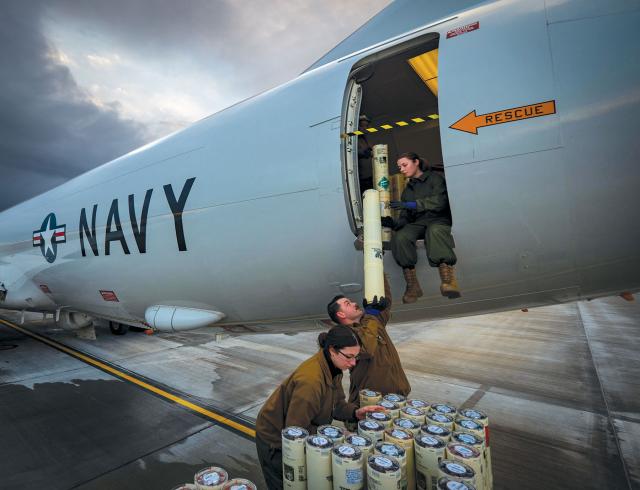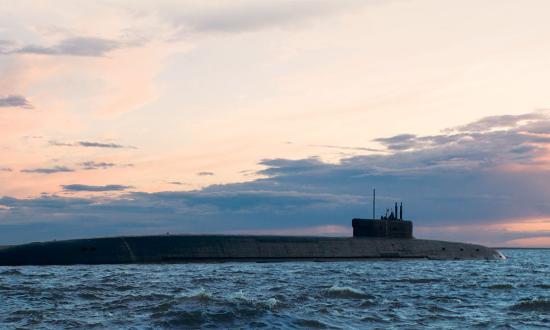Chairman Mao did not include the maxim “train like you fight” in his little red book, but the People’s Liberation Army Navy (PLAN) submarine force clearly understands it well enough. Its simulated cruise missile attack on the USS Ronald Reagan (CVN-76) in 2015 revealed how much Chinese capabilities and ambitions had grown since 2006, when a Song-class diesel-electric submarine surfaced within torpedo range of the USS Kitty Hawk (CV-63).1 Long-range, antiship cruise missiles (ASCMs) launched from a growing fleet of diesel submarines represent the pacing tactical threat for naval surface forces. The carrier strike group needs more and better antisubmarine warfare (ASW) platforms to defend against these increasingly potent weapons and defeat their stealthy launch platforms from standoff ranges. Fortunately, a variety of existing and emerging technologies can help distribute more sensors and more weapons on more platforms and catalyze novel operational concepts.
The Threat
In 2005, China bought eight Kilo-class submarines equipped with the SS-N-27 “Sizzler” ASCM, which boasts a 120-nautical mile (nm) range with a sea-skimming cruise followed by a terminal supersonic sprint. At the time, these missiles represented the worst-case submarine threat to carrier strike groups or surface action groups.2
The Chinese submarine force has since gained even more powerful weapons, while also growing in size and proficiency. The Department of Defense’s annual report on Chinese military capabilities noted that China’s “Song-class SS [13 hulls], Yuan-class SSP [17 hulls and counting], and Shang-class SSN [6 hulls] will field the PLAN’s newest domestic submarine-launched YJ-18 and its variants, which constitute an improvement over the SS-N-27 ASCM. […] The YJ-18 is a long-range, torpedo-tube-launched ASCM with a supersonic terminal sprint.”3 China already has more than 40 submarines capable of firing long-range and supersonic ASCMs, with new shipyards churning out more hulls at a worrying pace.4 Coupled with effective reconnaissance and over-the-horizon targeting, a few of these submarines could devastate a strike group almost anywhere in the theater with a massed, multiaxis attack.
Status Quo Falls Short
The emergence of Chinese submarine-launched antiship cruise missiles with third-party cuing means the submarine threat extends far beyond the reach of organic carrier-based helicopter ASW screens, which are fulfilling a mission to mitigate the threat of submarine-launched torpedoes. The MH-60R simply lacks the range, speed, and payload to conduct extensive searches at the ranges needed to protect the group from submarine-launched ASCMs.
The basic logic of distributed maritime operations applies to this increasingly difficult ASW problem: distribute more sensors and more weapons on more platforms, with better integration, to counter a greater threat. Though tactical ballistic missiles and nuclear submarines get more press, this potent threat must be countered if the Navy is to retain a credible conventional deterrent in the Indo-Pacific.
Long-Range Detection and Speed of Attack
“Awfully Slow Warfare” describes how ASW often feels to those searching for a submarine over days or even weeks, but the relative time scale shrinks abruptly with an inbound missile. Defending against threat missiles such as the YJ-18, with an estimated range of 120–290 nautical miles, requires sensors to detect them at launch and ASW weapons to quickly counterattack the emergent targets.5
If targeted ships can only detect incoming ASCMs as they crest the radar horizon going Mach 3 and there is no datum (submarine location at lost contact), the threat submarine can continue firing salvo after salvo of these long-range weapons with near impunity. Fortunately, artificial intelligence (AI) can help integrate existing strategic and tactical sensors. Connecting these potentially stove-piped systems could give maritime forces near-instant alert of missile launches, including submarine-launched ASCMs, allowing these forces to both prepare their missile defenses and prosecute the hostile submarine with a vengeance.
The space-based infrared system (SBIRS) detected Iranian tactical ballistic missile launches and gave soldiers at the targeted base in Iraq time to seek cover.6 The system likewise could detect the launch plume of an ASCM missile booster. Airborne systems such as the F-35’s AN/AAQ-37 Distributed Aperture System (DAS) and the F/A-18E/F Block III’s infrared search-and-track system (IRST) pod could even detect launches beneath cloud cover. However, these sensors lack timely integration.
The Missile Defense Agency has long invested in AI to recognize ballistic missile launches and rapidly fuse data from several sensors, and similar techniques could integrate sensors against smaller ASCMs.7 After SBIRS or DAS/IRST-equipped aircraft detected a possible booster plume, this AI-fueled tactical decision aid could filter the location against known air and surface contacts, slew other sensors to search for the missiles and launch platform, assess the probability of a submarine launch, establish an ASW datum if relevant, and vector ASW aircraft—all in a matter of seconds.
Long-Range Solutions for Long-Range Problems
Detecting a missile plume more than 200 miles away does little good for submarine prosecution if the only organic ASW asset is an MH-60R, because it would take more than an hour for it to arrive at the launch point—where the submarine undoubtedly no longer would be. To credibly defend a carrier strike group against ASCMs, the Navy needs platforms that can get there quickly enough to threaten a submarine.
Just as the E/A-18G took over the EA-6B’s mission with half the crew, a section of F/A-18Fs or F-35s configured for ASW could assume the role of the retired S-3 Viking and bring organic, fast, and long-range ASW back to the carrier air wing. An airborne ASW patrol could help pinpoint the target location with IRST, defeat inbound missiles with its own air-to-air missiles, and quickly reach the target area to both conduct an urgent attack and then deploy a range of sensors for follow-on prosecution. Rather than simply reinventing the S-3B on a new airframe, the Navy should use F/A-18s and F-35s to leverage smarter sensors, unmanned technology (including MQ-25s as wingmen), and novel weapons to track and attack distant submarines. However, because they lack the S-3’s long loiter time, they would need a new toolkit of persistent, mobile sensors and over-the-horizon relays to enable a new operational concept.
New Payloads in Familiar Packages
Recognizing the renewed importance of ASW, industry has started fitting sonobuoy pods to a variety of unmanned platforms, including MQ-4C Tritons, MQ-8C Fire Scouts, and MQ-9 Reapers. F-35 Lightnings, F/A-18 Super Hornets, and MQ-25 Stingrays also should carry pods such as the L3 Harris Sonobuoy Dispenser System (SDS), but it is equally important that they carry sonobuoy-form payloads far more capable than the existing inventory. Existing sonobuoys do not move with the target, and environmental conditions rarely support a probable detection range of more than a few thousand yards. Consequently, legacy airborne ASW platforms must continually lay sonobuoys in front of evasive submarines to generate a deliberate attack solution. Mobile sonobuoy-form payloads, on the other hand, could autonomously detect, track, and trail target submarines for hours.
Stanford University researchers working for the Office of Naval Research recently conducted a lab demonstration using a sonobuoy-form unmanned aerial vehicle (UAV) to track a submerged submarine without getting wet.8 Dubbed the photoacoustic airborne sonar system (PASS), these low-flying drones use lasers to vaporize water near the surface to generate underwater sound, which propagates like any other sonar ping. The UAV also carries an array of capacitive micro-machined ultrasound transducers (CMUT), which are sensitive enough to detect sonar returns across the water-air barrier. Swarms of these airborne sonar sensors could cooperatively search the area and then track any detected submarines. Adding a magnetic anomaly detector to these UAVs could further corroborate a detected object as a submarine and not, for example, a whale.
Tactical environmental conditions with a strong thermal layer could trap these sounds in the surface or mixed layer sound channel and prevent them from ever reaching a deeper target. This acoustic reality applies to any surface-based sonar, however, not just PASS. Getting a mobile sensor beneath the layer would complement these PASS UAVs and give the target submarine nowhere to hide.
Like a much smaller, slower, and cheaper torpedo, unmanned underwater vehicles (UUVs) deployed from sonobuoy tubes could help see beneath this acoustic layer. The Mk-39 Expendable Mobile Anti-Submarine Training Target (EMATT) has served as an affordable target for decades. Mating parts of this proven system with a low-cost active sonar system, perhaps using a CMUT array, would give ASW crews a mobile and autonomous acoustic sensor. Changes in the sensor’s sonar emissions, such as changes in the chirp profile or pulse repetition frequency, would alert other sensors and listening aircrew that the UUV had found something worth chasing.
Finally, an air-launched, medium-altitude UAV would allow fuel-limited jets to depart distant targets after deploying their weapons and sensors. These loitering drones would receive, bundle, and retransmit signals from the mix of airborne PASS UAVs and sonobuoys back to the carrier strike group, allowing ASW crews to continue tracking the target during gaps in manned aircraft coverage. Though such an air-launched UAV could launch from a sonobuoy tube, a larger UAV deployed from a bomb rack would allow longer loiter time. This overhead relay would also help tie distributed acoustic sensors into a novel multistatic sonar system.
Taking Multistatic Sensors to the Edge
Like most acoustic ASW systems today, both the PASS UAV and the EMATT-based UUV use bistatic sonar, with a collocated transmitter and receiver. While these tools would help the distant ASW fight, the Navy also should tie many other individual acoustic sensors, both new and old, into a multistatic sonar system-of-systems architecture to further improve search and localization. Unlike a bistatic sensor with a single transducer, any receiver in a multistatic system can process the echoes generated by any transmitter in the network, and by comparing return signals, the system can generate a target track. Serbian forces asserted that they employed multistatic radar to detect and shoot down an F-117 Nighthawk in 1999, and the P-8A Poseidon already employs the multistatic active coherent capability with specialized SSQ-125 sonobuoys and a powerful, open-architecture sonar processing suite.9
Continuing advances in computing efficiency and power facilitate edge processing, that is, processing most data at the device, rather than at a central server such as the one on board the P-8A. This basic systems architecture underlies the Internet of Things and 5G, but it could also unlock the widespread use of inter-platform multistatic sonar.
A cycle for this edge-processed multistatic sonar would start with a network “standby” message, pre-announcing the location, depth, acoustic profile, and time of a pending chirp. Distributed acoustic sensors within the network would then listen—first for the transmitted sound and then for any echoes. Each networked sensor, be it a passive sonobuoy, an active sonobuoy, unmanned surface vessel, or something else, would process these sonar returns locally and then broadcast its calculated target location along with the strength, direction, and Doppler shift of the return. This edge-processed multistatic sonar network would create a more complete acoustic picture, accelerating the localization and neutralization of threat submarines.
The edge-processing model also would enable sensors to listen passively for frequencies of interest and only transmit an alert message on hearing them. Although less useful than multistatic active sonar against a nearly silent diesel submarine drifting along on batteries, passive detection remains relevant for noisier nuclear submarines. The edge-processing model also would help preserve sensor battery life for both active and passive sonobuoys by reducing radio and sonar transmissions. Alternatively, shrinking the battery would allow each launching platform to carry more sonobuoys while still maintaining acceptable buoy life. However implemented, payloads and not the platform will dictate future ASW.
Attack! (Don’t Track)
F/A-18s, F-35s, and MQ-25s need weapons to quickly engage threat submarines with an urgent attack and follow-up with deliberate attacks as needed. For the near term, the Navy should flight test the existing Mk-54 lightweight torpedo for these aircraft, ideally with the High-Altitude Anti-Submarine Warfare Capability (HAAWC) guided wing kit. The same applies to the Compact Rapid Attack Weapon (CRAW), which weighs little more than an AIM-9X and could give these aircraft a capable ASW weapon for routine carriage.
These existing torpedoes have a major limitation: quantity. The Navy’s stockpile of lightweight torpedoes is limited, as is shipboard magazine space for these highly volatile, chemically fueled weapons.
The Navy could create an affordable and nearly unlimited antisubmarine smart weapon by transforming the humble depth charge. Following the basic configuration of Quickstrike air-dropped mines, this novel depth charge would use any Mk-80 series bomb, a high-drag ballute tail unit, and an underwater proximity fuse installed in the rear fuse well. Capacitive micromachined ultrasound transducers, which also enable the PASS technology, would allow a low-cost, highly reliable sonar sensor.10 Water impact would shear off the tail unit, after which the fuse would deploy a drogue-stabilized omnidirectional sonar transducer as it fell through the water. The depth charge would detonate just past the closest point of approach with the target submarine to maximize damage. The aircraft carrier’s magazine could store thousands of such fuses, ready to transform any Mk-80 series bomb into an instant ASW weapon.
Tag and Release
Finally, although the Navy needs more and better ASW weapons to attack threat submarines, it also needs better antisubmarine tools to manage conflict escalation short of armed conflict. During the Cold War, NATO ASW forces experimented with magnetic noise makers that were dropped in bulk on Soviet submarines, and used practice depth charges to warn off Soviet submarines during the Cuban Missile Crisis.11
Updating the magnetic noisemakers into low-cost and expendable command-activated acoustic beacons could help avoid such dangerous confusion during a future crisis, while also providing a tactical advantage if that crisis tipped into war. These could be deployed from repurposed Rockeye cluster munition dispensers, sonobuoy-shaped dispensers, or with more precision by UUVs such as the one proposed above.
No single emerging technology or novel tactic can solve the challenge of long-range, submarine-launched antiship cruise missiles. ASW platforms will have to not only detect launches but also get to them in time to prosecute them. The speed and range of fixed-wing, carrier-based aircraft equipped with sonobuoy launchers, mobile sensors, and advanced ASW weapons could help recover much of the S-3 Viking’s capability. Weaving a variety of these emerging tools and techniques into new operational concepts can do that and more.
1. Franz-Stefan Gady, “Chinese Submarine Simulates Cruise Missile Attack on US Aircraft Carrier,” The Diplomat, 21 December 2015; “Chinese Sub Came Close to U.S. Ships,” CBS News, 14 November 2006.
2. “China Submarine Capabilities,” NTI (7 February 2021).
3. “Military and Security Developments Involving the People’s Republic of China 2020,” Department of Defense (2020).
4. H I Sutton, “China Increases Production of AIP Submarines with Massive New Shipyard,” Naval News, 16 February 2021.
5. “Chinas’ New YJ-18 Antiship Cruise Missile,” U.S.-China Economic and Security Review Commission, 28 October 2015.
6. Nathan Strout, “How the Space Force Foiled and Iranian Missle Attack with a Critical Early Warning,” C4ISRnet, 7 January 2021.
7. “Intelligent RF-IR Data Fusion Using Artificial Intelligence Techniques,” award information, SBIR.gov (2013).
8. Aidan Fitzpatrick, Ajay Singhvi, and Amin Arbabian, “An Airborne Sonar System for Underwater Remote Sensing and Imaging,” IEEE Access, 16 October 2020.
9. Arend G. Westra, “Passive Radar and the Future of U.S. Military Power,” Joint Force Quarterly, no. 44 (4th Quarter, 2009): 136–43; John Keller, “Boeing to Upgrade Sonar Signal Processing on Navy P-8A ASW Aircraft,” Intelligent Aerospace, 27 February 2017.
10. Muhammad Sabri Salim, MF Abd Malek, RBW Heng, et al., “Capacitive Micromachined Ultrasonic Transducers: Technology and Application,” Journal of Medical Ultrasound 20 (2012).
11. “NATO Bombed Soviet Submarines with Tiny, Annoying Magnets,” War is Boring, 18 February 2014.








